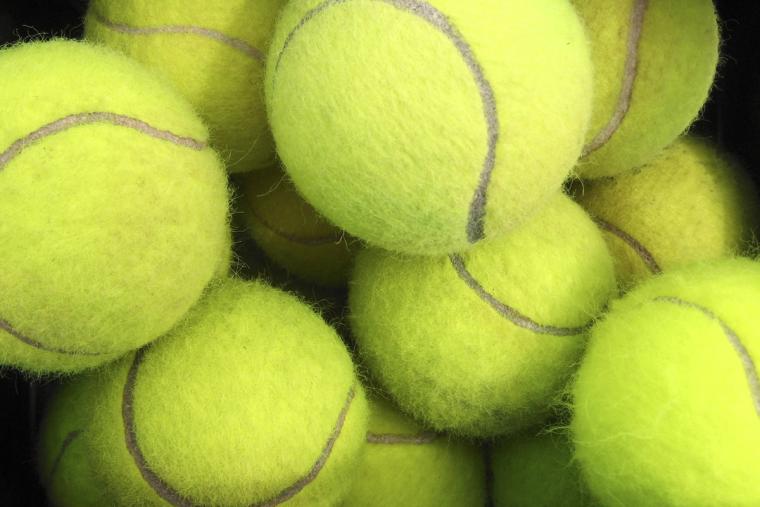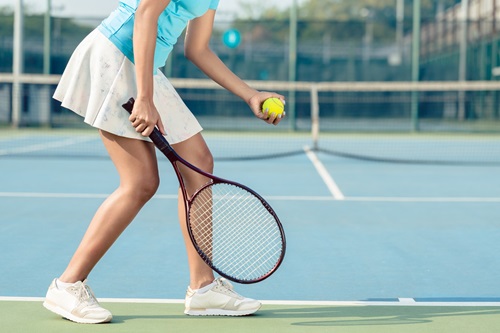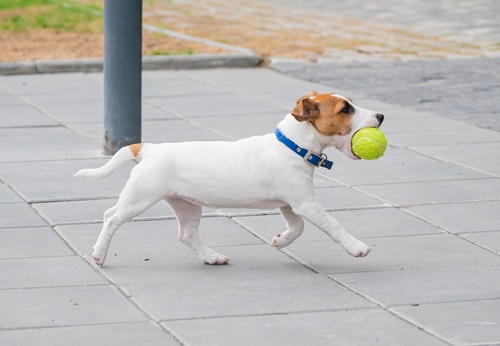
Photo © Dmitry Yashkin | Dreamstime.com
Trophy recycling. Shoe recycling. What’s next? Tennis ball recycling, meaning that optic yellow (yes, that’s the official color of tennis balls) is the new green.
While many things germane to sports events remain on the I-wish-they-were-recyclable list (*cough cough! those red Solo cups! cough cough!*), the fuzzy balls used by the gross in tennis tournaments are finding new purposes through a variety of programs. Collect ‘em, ship ‘em, congratulate yourself.
The numbers speak for themselves. According to industry sources, 325 million tennis balls are manufactured annually, and 130 million balls are played with every year. Nationwide, approximately 125 million used tennis balls go into U.S. landfills every year, representing 20,000 metric tons of methane-producing rubber waste that takes 400 years to decompose.
At the recreational level, balls may have longer use times since players and programs may save balls from game to game. Tennis coaches at clubs and schools may keep rolling carts and hoppers filled with balls to use. At professional tournaments, however, the New York Times notes, the ball demand is much greater; in tournament play, six balls are used to start a match, then discarded after seven games. For the remainder of that match, the balls will be replaced after every nine games. (The US Open generally stocks about 100,000 new balls and goes through about 70,000 each year.)

It all adds up to a lot of balls on the market. Here is a snapshot of the current ball recycling programs.
Tennis Ball Recycling (www.tennisballrecycling.com) leverages a partnership with tennis surfacing manufacturers, Laykold and Ace Surfaces. Balls are collected, shipped to the processing facility and recycled into a tennis court surfaces known as the Laykold Masters 5 or 8.
Recycle Balls (www.recycleballs.org) accepts shipments of tennis balls (including a pre-paid shipping label) and turns them into crumb rubber for various uses. (Bonus: It also provides a tax donation.)
Recycle Balls Second Throw (secondthrow.recycleballs.org) is a division of Recycle Balls; however, it accepts balls that have been used in dog parks, chewed on, etc. and grinds them into crumb rubber to be used as equestrian footing.
USTA Recycled Tennis Ball Program (link here) differs from other programs in that it makes tennis balls available to not-for-profit organizations, including schools, assisted living facilities and animal shelters.
Local Uses: Outside of national programs, tennis ball reuse opportunities exist at the grassroots level in cities nationwide; they include the following:
- Animal Shelters (call first to see which shelters will accept donations of balls; in addition to large municipal shelters, reach out to independent operations and breed-specific rescues)
- Dog Parks: Dog parks have been growing in popularity nationwide; in fact, according to SniffSpot, there was a 40 percent increase in public dog park development between 2009 and 2020). Many may accept tennis balls, particularly if donations are put in weather-resistant containers.
- Dog Day Cares: Another business model on the grow is the dog day care; these are popping up in many cities, and tennis balls may present a good diversion for dogs, as well as being something staff does not have to purchase.
- Nursing Homes/Rehab Centers: Tennis balls are often punctured to go onto the bottoms of walkers, which decreases friction and allows the walker to be pushed more easily; this site has more information on the how and why.
- Schools: Schools can use tennis balls in a variety of ways, including in gym classes. Many schools puncture balls and put them on the feet of desks and chair legs, which keeps them from marking floors and, in the case of children with sensory processing challenges, making quite so much noise when moved suddenly. They may be used in the home as well to keep furniture from damaging hardwood floors. (However, not everyone is in favor of using tennis balls this way.)
- Local Sports Programs: If balls are still in good playing shape (meaning they have their original bounce and the felt is undamaged), they may be able to be donated to youth programs that might be glad to have balls they don’t have to buy.
Refreshing Balls for Longer Lifespans: It’s no secret that tennis balls lose their ability to bounce well after multiple instances of play. In the past, what were known as “dead” balls were discarded; however, new technology on the market allows venue owners to collect and repressurize balls for future use. Once the felt covering the balls has become worn, balls can be passed along the chain to the recycling programs mentioned above.
Recycling Tennis Ball Cans: Packaging for tennis balls is recyclable; however, to give the package the best possible chance at making it through the recycling process, cut off the metal ring at the top and recycle both.

Essential points for event owners to note when considering tennis ball recycling:
- Research what fees apply when donating to nationwide recycling programs (some companies may just require event owners to pay shipping for balls, while others may have prepaid postage).
- When making the decision to donate balls locally (animal shelters, nursing homes, schools, etc.), find out in advance whether organizations are willing to accept tennis balls (and in what quantities). Some may have limited capabilities for storage.
- If you put out cartons to accept tennis balls, people may be so enthusiastic about donating items that they may bring other balls that have been used (pickleballs, etc.) and put them all into the bins – so event owners or volunteers will likely need to spend some time parsing through donations prior to sending them off. Some donations may need to be passed along to charities if the tennis ball recycling partner cannot use them.
- If you are planning to have a box onsite into which balls can be dropped, keep an eye on the box so that it does not get over-full.
- Do a press release to local media, promoting both the event and its ability to recycle balls. Good news about green initiatives is often picked up for coverage. If working with a national company that does ball recycling, be sure to name the partner and describe its work.

